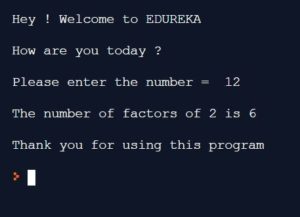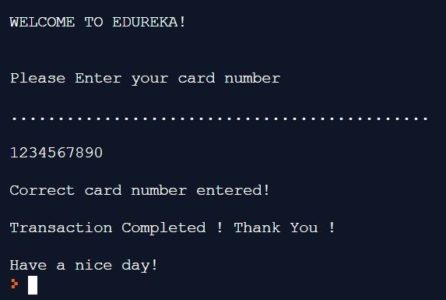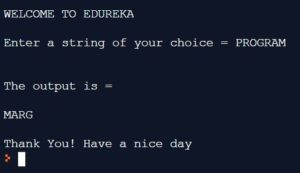Data Science with Python Certification Course
- 131k Enrolled Learners
- Weekend
- Live Class
No matter how much one would chose to ignore it, it is imperative to understand that we live in a fast-pasted tech savvy world where things around us change rapidly. The key factor that has led to this outburst of technological revelations is credited to the rise in software industry. A few years ago, software was bundled in with the hardware bought. It was never considered to have great value. However, the scenario today is quite different. In this article, Why Python language and how it is the new “in thing” in todays’ IT world.
Following pointers will be covered in this article,
One of the key features of python language is its simplicity in code writing. It uses 1/5th of the code when compared to other object oriented programs. This factor makes it the most sort after language used in trending domains like AI. AI has a wide horizon under which it deals with machine learning and deep learning.
Python has a variety of libraries that appeal to the needs of any programmer. It has some prebuilt libraries such as Numpy, SciPy, Pybrain etc., which are for advance and scientific computing. Python is platform independent, which makes it quite flexible in interfacing between other technologies. In addition, the current user base of the language is very diverse. Most python developers share queries and solutions on portals, which make it a comprehensive knowledge resource as well.
The language not only applies OOPs concepts but incorporates a scripting approach as well. There are numerous IDEs (Integrated Development Environment) like PyCharm, which allows users to carry out complex codes and algorithms of AI related projects. In an AI’s SDLC (Software Development Life Cycle) phase like testing, debugging and development, it becomes a cakewalk, when compared against other contemporary programming languages like Java, Javascript and Pearl.
These languages would definitely yield desired results but would make tasks cumbersome. Hence, looking at the numerous advantages of python, there is no doubt that it plays a crucial aspect in today’s AI technologies.
One of the reasons that makes have this question ‘Why Python?’ is the application below
Deep learning is another trending domain in todays’ world of Artificial Intelligence. Deep learning techniques are so powerful because they represent and learn of how to solve a problem in the best possible way. This is called as “Representation Learning”. The deep learning programs are trained with numerous examples that make its predictions accurate. Deep learning models are extensively used in colorizing images and videos. It is used in identification of objects in photographs popularly termed as ‘face-recognition’.
Python is the best platform to get started with deep learning models. Python is quick and easy to understand. It has a ton of features that make deep learning projects faster to operate and develop. The two most versatile libraries used by any deep learning expert is “Theano” and “Tensorflow”. These are quiet technical and used exhaustively by research groups. The “Keras” library is written in pure python which provides an interface for the above two libraries.
Moving on with this article on ‘Why Python?’ let us see how much would you make as a python developer,
If you are currently, a python developer this part might be music to your ears. We have discussed the value that python carries in today’s tech space and there is no reason not to believe that developers are paid handsomely. The average salary is about $123,743 as per “Googroo” and “Indeed” websites. Python lives up to be the hottest skill any IT professional can possess in this generation. The below graph shows a sharp spike for Python developers as compared to other languages.

Next in this article on ‘Why Python?’ we would see how Python fares as a programming language
Now that we know how important Python is to the world and us. Let us deep dive into learning some of the technical aspects of the programming language. The below illustrated topics are rudimentary and would be easy to grasp.
The break command in python is a commonly used to terminate the usual flow of a program abruptly. It is very similar to the break statement used in C programming. Let us consider the below illustration for clarity. This program checks for the number of factors of a number entered by the user. The while loop acts as an infinite loop that never terminates the program. Based on the user input, the number of factors is computed or in case user input is zero, appropriate statements are presented. After the execution of the entire program, the infinite iteration is withheld by the break command. In its absence, the program will run indefinitely.
while(1):
print("nnHey ! Welcome to EDUREKA n")
print("How are you today ?")
a=int(input("nPlease enter the number = "))
count =0
if (a==0):
print ("nnPlease enter non zero numbern")
print ("This program is now terminatedn")
print ("Thank You")
else:
for x in range (1,a+1):
if (x%2==0)
count = count+1
print ("n The number of factors of 2 is", count)
print ("n thank you for using this programn")
break;Output
 Next in this article on ‘Why Python?’ we will cover some basics Python Programming
Next in this article on ‘Why Python?’ we will cover some basics Python Programming
Variables in Python are like containers to store certain some data values. Python does not have any particular method of declaring variables before utilizing them. The data type of such variables can be changed anywhere in the program flow. However, there are a few rules to follow while variable declaration:
In Python, we can assign variables differently.
Using the “+” symbol we can add variables. If strings are stored in those variables then we refer to this as concatenation. If they store arithmetic values, then we consider it as usual mathematical calculations.
It is mandatory to note that one should ensure homogeneity while performing such operations. The variables that carry different datatypes should not be combined. If X=1000 and Y=”DATA SCIENCE”. The X+Y would throw an error.
Let us understand what is slicing?
Slicing in python is to derive a sub string from a main string. Consider the below illustration of code.
print("nWelcome to Edurekan")
pyString=input("Enter a string of your choice = " )
print("nn The output is = n")
print(pyString[slice(0,3)])
print("nThank you! have a nice day ") Output
 In the below example, “ICCWORLDCUP” is a string, which is a user input. The sub string derived from the program is “ICC”. How did this happen? The main statement responsible for this functionality is line 24. The index of the slice function picks out the characters from index 0 (starting index) and goes up to index 2. Within the range of 0,3 the letters ICC become a new string and this is the output.
In the below example, “ICCWORLDCUP” is a string, which is a user input. The sub string derived from the program is “ICC”. How did this happen? The main statement responsible for this functionality is line 24. The index of the slice function picks out the characters from index 0 (starting index) and goes up to index 2. Within the range of 0,3 the letters ICC become a new string and this is the output.
Another way of slicing is with regard to negative index. This is also a good way for substring reversal. The parameters for string slicing function increases to 3. The first being the starting index from the end of the string, the second being the ending index and the third being the interval. Let us have a look.
print("nWELCOME TO EDUREKA n")
pyString=input("Enter a string of your choice =")
print("n nThe output is = n")
print(pyString[slice(-1,-5,-1)])
print("nThank You ! Have a nice day")Output
 In the ‘slice’ function, the first -1 points at the last letter “M” of the string. The cursor counts backwards with an interval of 1 and stops after 4 counts which leads to the output “MARG” which is the last 4 letters “GRAM” being reversed.
In the ‘slice’ function, the first -1 points at the last letter “M” of the string. The cursor counts backwards with an interval of 1 and stops after 4 counts which leads to the output “MARG” which is the last 4 letters “GRAM” being reversed.
This brings us to the end of this article.
To get in-depth knowledge on Python along with its various applications, you can enroll here for live online training with 24/7 support and lifetime access. Got a question for us? Mention them in the comments section of “Why Python?” article and we will get back to you.
 Thank you for registering Join Edureka Meetup community for 100+ Free Webinars each month JOIN MEETUP GROUP
Thank you for registering Join Edureka Meetup community for 100+ Free Webinars each month JOIN MEETUP GROUPedureka.co